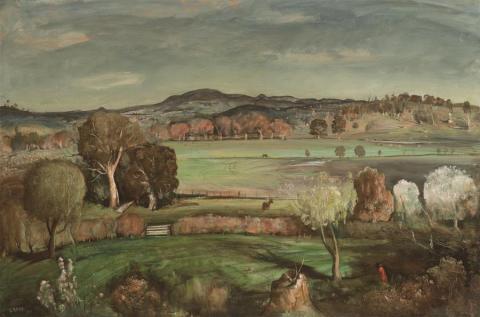NEAR ORANGE, 1952
LLOYD REES
oil on canvas
68.0 x 102.0 cm
signed and dated lower left: L REES / 52
Commissioned from the artist in 1952
Private collection, New South Wales
Thence by descent
Private collection, New South Wales
Landscape Near Orange, 1952, oil on canvas on board, 30.5 x 45.5 cm, collection of the Art Gallery of New South Wales, Sydney
When Lloyd Rees died in 1988 the nation lost one its most loved and admired artists. Despite the public outpourings of grief and recognition, Rees had not always been held in such esteem. During his long career he slipped in and out of prominence, working for many years in relative obscurity as artistic taste moved on from the meticulous work and fine draughtsmanship that marked much of his work. He was a man of great knowledge and wisdom, a gifted teacher and stalwart friend to many in the art world and the wider community. Granted his first retrospective at the Art Gallery of New South Wales in 1942, Rees seemed destined for great things. But the war brought change, disruption and in its wake, the rise of modernism and the challenge of abstraction. A younger generation of artists embraced the new styles and those who produced modest works of a domestic scale fell from the public eye. The popular press, television and the commercial world craved spectacle and there was little room for finely crafted landscapes and views of the inner city, no matter how skilful the rendition. After the war Rees took a post at the University of Sydney, teaching drawing and art history in the school of architecture. Less dependent on commercial work and major sales, he was happy to work away out of the public eye.
Lloyd Rees moved to Gerringong on the New South Wales South Coast in 1947 and produced a series of fine landscapes of the rolling coastal hills, including his best-known work, The Road to Berry, acquired by the Art Gallery of New South Wales in the same year. It was perhaps with that picture in mind that a pastoral family approached Rees in 1952. Their property was one of the most important stations west of the Divide, a fitting subject for a landscapist of Rees's ability. In that year Australia was deeply entrenched in the Korean War, a conflict that brought an unprecedented boom in wool prices and pastoralists rode high on wool at a 'Pound a pound'. The property was centred around a grand homestead and had featured prominently in Australia's exploring and pastoral history. It is significant that Rees chose to depict the view from the homestead, rather than producing an intricate architectural study of the grand house, with its spreading white verandahs and imposing stance on the crest of a rise. He places a view of the garden, with a lone figure, and a view across the paddocks to Mount Canobolas. It is an ordered composition, a comforting and satisfying view of the settled landscape. A tiny figure on horseback and one lone cow enliven the middle ground, with some speckled white dots a sign of the great Merino flocks that made the property famous.
GAVIN FRY
